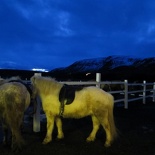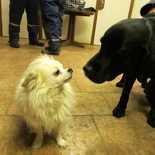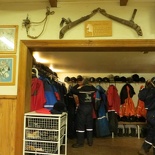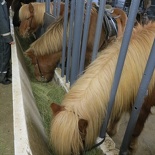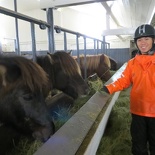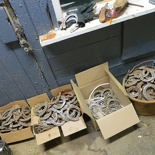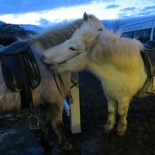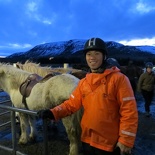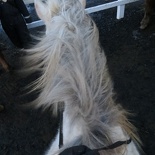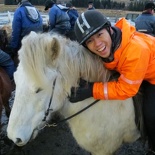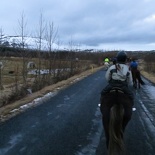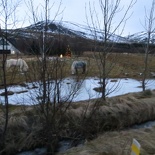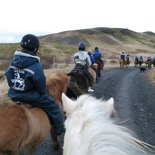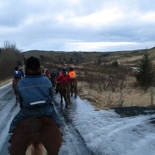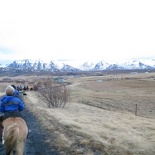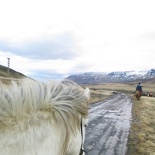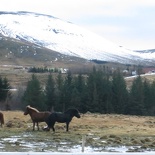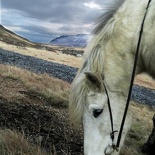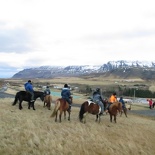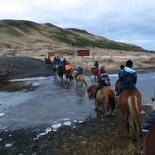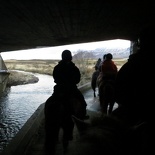No trip in Iceland will be complete without experiencing the countryside riding on a traditional Icelandic horse, just as how the Vikings did it in the last millennium. Icelandic horses are rather small horses and are just slightly larger than a pony when fully grown. They were chosen by the immigrant Vikings during 800-1000 AD on the dawn of Icelandic society given their small sizes.
During their initial human migration, space on board sailing ships were a premium when traveling on the high seas. The small horses were developed from ponies taken to Iceland by Norse settlers between the 9th and 10th centuries, where they could be easily fitted in the storage holds of the Viking ships in adequate numbers required for a new settlement.
The breed is mentioned in literature and historical records throughout Icelandic history; the first reference to a named horse appears in the 12th century.
Daylight is pretty much a premium here in the Icelandic winter, thus much of the day started in the wee hours of the morning with a 2 hour drive from town into the horse farm located in the Icelandic snow-capped mountain ranges. There, we were greeted by our guide for the day who will be riding with us into the mountains. After introductions and suiting us up with warm riding gear and high visibility jackets, we were brought about the stable area and introduced to the various horses we will be taking out for the day.
There, we were given a brief run down on how the farm operates, their equine care and feeding procedures. The breed has a double coat developed for extra insulation in cold temperatures. We were also given an introduction to each of the stable head’s own personal horses, each with their own unique habits which the trainers simply adore. The breed is known to be hardy, have few diseases, and is an easy keeper.
Horses are allocated based on the size of the rider as well as riding experience. Icelandic horses weigh about 350 kg and about 1.32 to 1.42 meters tall; their current form is much the work of natural selection and selective breeding over the centuries. In comparison to the larger horses we know, these horses are pony-sized, despite being fully grown adult size.
Icelandic horses weigh about 350 kg and about 1.32 to 1.42 meters tall; their current form is much the work of natural selection and selective breeding over the centuries.
Icelandic breeders and breed registries always refer to Icelandics as full adult horses. This is so as the Icelandic horse weight, bone structure and weight-carrying abilities is close to that of a fully grown large horse, rather than a pony, with well-proportioned body structure seen in mature horses. This includes head and wide foreheads, muscular and broad necks, chest and shoulders and legs muscular.
The Icelandic horse is a breed of horse developed natively here in Iceland and is the only breed of horse on the island. They are also popular internationally, and sizable populations exist in Europe and North America. The breed is still used for traditional sheepherding here, as well as for leisure (like in this case), showing, and racing. Although the horses are small, at times pony-sized, most registries for the Icelandic refer to it as a horse.
These horses have a very distinctive furry and hairy hide, coupled with rather thick body fat which is unique to only this kind of horses globally. They are long-lived and hardy. This allows these horses to stay and live outdoor perpetually throughout the year, even in the cold harsh Icelandic winters. Icelandic law prevents horses from being imported into the country. There is quite a reasonable market for such unique Icelandic horses and horse export, though exported horses are not allowed to return. In Iceland, farmed horses were also reared for domestic consumption of horse meat. It is a seasonal delicacy in the country as well. Though I am not really a fan of eating what I’ve ridden at the end of the day!
I had been on horse riding a couple of times before, though I had been quite out of practice in riding long distances, let be remembering how to control one well. But I expected myself to slowly grasp and remember the handling naturally as the ride progressed, I was paired up with a white stallion which name roughly translates to something along the lines of “the high seas”.
There was an odd 20 over horses in the convoy, led by our stable guide who rode bareback for the whole cross country trek. Much of the highland trail areas were all completely frozen, which will make walking even for me without slipping quite a challenge, let be for the horses. But this was not much the case for the horse with their well-equipped assortment of spiked horseshoes which made traversing the large frozen areas with much ease.
The first part of the trail journey saw pretty much a slow familiarization walk in the lined convoy to get used to our horses with an occasional buttock-bumping horse trot. The horses themselves are pretty used and trained to convoy riding and will automatically catch up and follow the horse directly in front of them. This “horse autopilot” feature is particularly useful for beginner riders who do not know how to take control of the horse they are on. The first half of the warm-up journey was much of a bore for rider and horse alike.
It didn’t take long before I got to read into my horse on what he likes to do. My horse in particular is a rather cheeky one and he simply loves to run, often liking to create space in front of him and play catch up the horse in front of him, often with a rapid trot or a quick gallop, only to slow down right disapprovingly in front of the horse before him with no more space to run. Also amusingly, he is also a very hungry one, often getting distracted at times and always naturally helping himself to any available grass he can nibble on by the trail each time we stop for a rest break.
The second half of the journey saw us riders being allocated into a slower and faster riding group of about 10 riders based on rider skill. I was on the faster group looking for more thrills. This part of my cross country trek was led at a much faster pace by our group guide, who rides bare back on her horse. Soon after, we saw ourselves galloping through several mountainous roads around the region. You can quickly solve the problem of the uncomfortable trot by simply standing up slightly in your saddle, yet keeping your center of gravity low or simply getting your horse to gallop, after all, that is what my horse really wanted and loved to do.
The Icelandic horse displays two gaits in addition to the typical walk, trot, and canter/gallop commonly displayed by other breeds. Galloping your horse is often very much smoother unlike the trot, which may often give you back aches at the end of the day. The key thing here is to have both the rider and horse in-sync with the fast forward motion, making it a rather enjoyable experience.
There were several water crossings made through the riding route, with crossings over streams and slow-flowing river crossings, which will leave your legs pretty damp at some points with the horses trotting and splashing over the rivers at speed. The fun part is of course getting your horse to run flat out on the open plains, with in particularly what my horse wanted.
I was even commended at the end of the day by our lead guide on being a rather natural horse rider and excellent in my ability to control the horse I was on very well, as sometimes horses can get rather stubborn at times and you have to show them who is the boss. Our group stayed out in the wilderness for about 2 hours before heading back to the stables to wrap up the day. We de-geared the saddles and freed the horses from their bridles allowing them to wander out in the open paddocks for a rest after the ride.
The best part of going riding with a family-run farm are the baskets of home-made cake and cookies waiting for us upon our return, all freshly baked by the wife of the stable head and shared in the living room of the house attached to the barns and stables.
A great way to end a great ride indeed.
More horse riding photos here.

